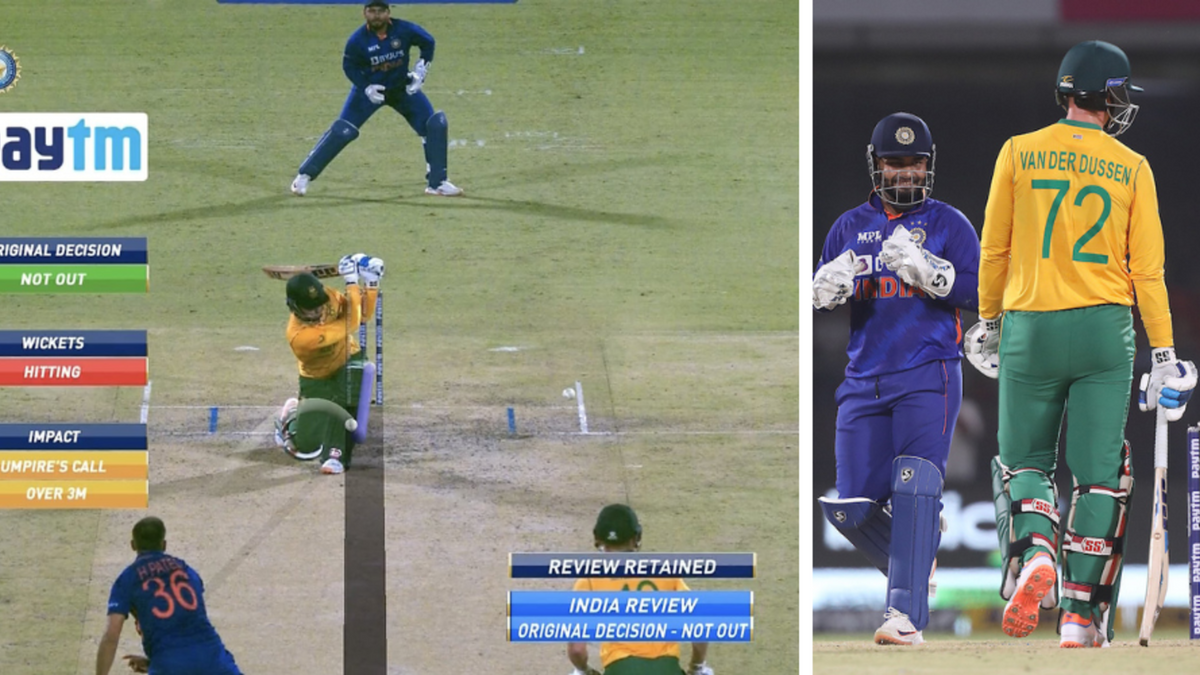
A controversial lbw decision during the first T20I between India and South Africa sparked a debate over the playing conditions concerning DRS, with Rassie van der Dussen was ruled not out despite replays seemingly suggesting he was ‘plumb’.
Clause 3.4.6.4 under Appendix D of the ICC men’s T20I Playing Conditions, which pertains to reviewing lbw dismissals, was invoked on Thursday during the penultimate over of the South African innings. The rule states, “When a not out decision is being reviewed, where the evidence shows that the ball was hitting, the point of first interception was in line, and the ball pitched in line or outside off, but that the point of first interception was 300cm or more from the stumps, the on-field decision shall stand (that is, not out).”
In short, if a batter is given not out after an lbw appeal and the decision is reviewed, and if the distance between the batter and the stumps at the point of impact is three metres or more, then the decision will be not out, no matter what ball-tracking says.
The rule came into play at a pivotal moment, with South Africa needing 11 from nine balls to win, and Harshal Patel having begun the penultimate over well, conceding just one run from his first three balls. With his fourth ball, he attempted a yorker hit van der Dussen’s thigh pad after the batter came down the track and missed an attempted slog-sweep. The on-field umpire turned down the appeal, but with the ball seemingly hitting the batter plumb in front, India captain Rishabh Pant went up for the DRS.
Replays showed the ball was indeed hitting the right-hander in line with the stumps, and projected that the ball would have gone on to hit the stumps, but the TV umpire upheld the on-field umpire’s verdict as the impact was over 300cm from the stumps.
Even though the right decision was made according to the playing conditions, many questioned the law itself. Some argued that since the ball had hit the batter right in front of the wickets, then even if the distance between the player at the point of impact and the stumps incurred a greater margin of error, a decision could still be reached with a high degree of accuracy.
Even with a big margin of error that is smashing into leg stump
— Peter Miller (@TheCricketGeek) June 9, 2022
Not sure about that 3m rules, Van Der Dussen was as plumb as they come 🤷🏽♂️ #INDvsSA
— Saqib Mahmood (@SaqMahmood25) June 9, 2022
Van der Dussen’s dismissal would have left the visitors needing 11 more in the last eight deliveries, with debutant Tristan Stubbs expected to walk out next. Instead, the No.4 hit the next delivery to the fence, and South Africa wrapped up the game with five balls to spare.
This is not the first time that India have been at the receiving end of this law. Another similar incident had panned out in 2011 during a World Cup clash between India and England after Ian Bell had been struck in line of the stumps and the on-field umpire ruled him not out. Though the ball would have gone on to hit the stumps, as he was 2.5 metres down the pitch, the England batter was ruled not out after the DRS was taken by the fielding side. The batter, who scored 69 off 71 in the tied game, later said the rule was “strange”.
“I didn’t even know that rule existed. As soon as I saw it pitch in line and hit, I thought that was enough. It’s strange, to be honest with you if you see Hawkeye saying it’s going to hit the stumps. It’s a little bit strange.”








